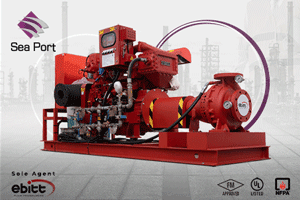Firefighting Pump: Empowering Effective Fire Suppression and Safety
firefighting pump is a crucial piece of equipment designed to combat and control fires effectively. It is a powerful device that engineers specifically designed to provide a reliable supply of water or firefighting pump foam. These pumps help firefighters, emergency response teams, and industrial facilities extinguish flames and prevent the spread of fire. Firefighters can use these portable, durable, and easy-to-operate pumps to quickly establish a water source and deliver high-pressure water to douse flames.
Importance of FireFighting Pump in Emergency Response:
Fire pumps serve as critical components in emergency response scenarios due to their key attributes and functionalities. Understanding the importance of these pumps can be summarized into several significant points:
Rapid Fire Suppression: A firefighting pump enables rapid fire suppression by delivering high-pressure water streams. The forceful water discharge helps extinguish flames quickly and efficiently, minimizing the spread of fire and reducing potential damage.
Mobility and Accessibility: The firefighting pump is designed to be mobile and can be easily transported to the site of an emergency. This mobility ensures that firefighters have immediate access to a reliable water supply, regardless of the location or accessibility of nearby hydrants or water sources.
Alternative Water Sources: When the regular water supply is compromised or insufficient, firefighting pumps can draw water from alternative sources such as lakes, rivers, or swimming pools. This capability ensures a continuous water supply, even in remote areas or during extended firefighting operations.
Penetration of Barriers: The high-pressure capabilities of firefighting pumps allow them to penetrate barriers such as walls or roofs. This feature enables firefighters to reach inaccessible areas and extinguish hidden or smoldering fires, preventing further damage and potential re-ignition.
Versatility and Adaptability: Firefighting pumps are versatile tools that can be connected to hydrants, water tanks, or other water sources. This adaptability ensures a steady flow of water during firefighting operations, regardless of the availability or condition of existing water infrastructure.
Advanced Features: Many firefighting pumps have advanced features to enhance their efficiency and effectiveness. These features may include self-priming mechanisms, foam induction systems, or adjustable pressure settings. Such enhancements improve the pump’s performance and enable firefighters to tackle various types of fires.
Life and Property Protection: The primary goal of firefighting pumps is to protect lives and property. By providing a reliable water supply and facilitating effective fire suppression, these pumps significantly contribute to minimizing casualties, reducing property damage, and preserving valuable assets.
Working Principles of Fire Pumps: How They Function
Firefighting pumps function based on fundamental principles that enable their effective operation. These principles include water intake, priming, impeller rotation, water acceleration, pressure generation, discharge, cooling, and continuous operation.
The pumps draw water from various sources, create a vacuum through priming, and use impeller rotation to accelerate water, generating high pressure.
It is a powerful device that engineers specifically designed to provide a reliable supply of water or firefighting pump foam. These pumps help firefighters, emergency response teams, and industrial facilities extinguish flames and prevent the spread of fire. Firefighters can use these portable, durable, and easy-to-operate pumps to quickly establish a water source and deliver high-pressure water to douse flames. When selecting a firefighting pump, one should carefully evaluate factors such as flow rate, pressure rating, and power source to meet the specific needs of the intended application.
Fire Pump Efficiency: Maximizing Water Flow and Pressure
Efficiency plays a crucial role in firefighting pump systems as it directly impacts the water flow and pressure, which are vital for an effective firefighting pump. Maximizing water flow and pressure ensures that firefighters have the necessary tools to combat fires swiftly and efficiently. Here are some key points to consider when aiming to maximize the efficiency of firefighting pumps:
Pump Selection:
Choosing the right firefighting pump is paramount. It is a powerful device that engineers specifically designed to provide a reliable supply of water or firefighting pump foam. These pumps help firefighters, emergency response teams, and industrial facilities extinguish flames and prevent the spread of fire.It is a powerful device that engineers specifically designed to provide a reliable supply of water or firefighting pump foam. These pumps help firefighters, emergency response teams, and industrial facilities extinguish flames and prevent the spread of fire.
Firefighters can use these portable, durable, and easy-to-operate pumps to quickly establish a water source. They can then deliver high-pressure water to douse flames.
When selecting a firefighting pump, one should carefully evaluate factors like flow rate, pressure rating, and power source. This helps meet the specific needs of the intended application.
Pumps with higher flow rates and pressure ratings can deliver more water to the fire. This increases the chances of successful extinguishment.
Proper Pump Maintenance:
Regular maintenance is essential to keep the firefighting pump operating at peak efficiency. This includes routine inspections, cleaning, lubrication, and addressing any potential issues promptly. Regularly checking and replacing worn-out or damaged parts, such as seals and impellers, ensures optimal pump performance.
Adequate Water Supply:
To maximize water flow and pressure, a reliable and sufficient water supply is crucial. Firefighters must ensure that there is an adequate water source nearby, such as hydrants, static water tanks, or natural water bodies. Properly connecting the pump to the water source and minimizing any restrictions or obstructions in the supply line helps maintain optimal flow and pressure.
Training and Skill Development:
Proper training and skill development for firefighters are essential to maximizing the efficiency of firefighting pump operations. Training should focus on understanding the pump system, operating controls, and techniques for optimizing water flow and pressure.
By implementing these strategies, firefighters can maximize the efficiency of firefighting pumps, ensuring the highest possible water flow and pressure during firefighting pump operations. This ultimately enhances their ability to combat fires effectively, protect lives, and minimize property damage.


